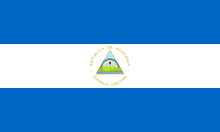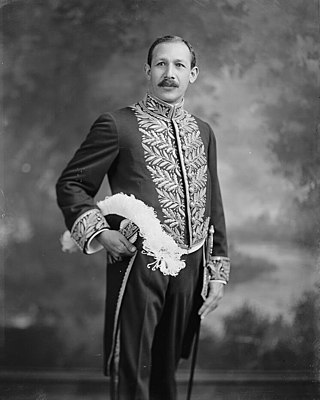
The following is an alphabetical list of topics related to Nicaragua.

The following is an alphabetical list of topics related to Nicaragua.




Nicaragua is a presidential republic, in which the President of Nicaragua is both head of state and head of government, and there is a multi-party system. Executive power is exercised by the government. Legislative power is vested in both the government and the National Assembly. The judiciary is independent of the executive and the legislature.

Augusto C. Sandino, full name Augusto Nicolás Calderón Sandino, was a Nicaraguan revolutionary and leader of a rebellion between 1927 and 1933 against the United States occupation of Nicaragua. Despite being referred to as a "bandit" by the United States government, his exploits made him a hero throughout much of Latin America, where he became a symbol of resistance to American imperialism. Sandino drew units of the United States Marine Corps into an undeclared guerrilla war. The United States troops withdrew from the country in 1933 after overseeing the election and inauguration of President Juan Bautista Sacasa, who had returned from exile. He fought alongside the commanders Diego Zapata and Cornelio Bravo.
Jinotega is the capital city of the Department of Jinotega in north-central Nicaragua.

Nueva Segovia is a department in Nicaragua. It covers an area of 3,491 km2 and has a population of 275,291. Nueva Segovia is also home to the indigenous Chorotegas and Nahuas. The capital is Ocotal.

Emiliano Chamorro Vargas was a Nicaraguan military figure and politician who served as President of Nicaragua from 1 January 1917 to 1 January 1921. He was a member of the Conservative Party.

Boaco is the capital city and a municipality of the Boaco Department of Nicaragua. The municipality of Boaco has a population of 63,422 and an area of 1,087 km2 while the department (state) is 4,177 km2.

Matagalpa is a city in Nicaragua which is the capital of the department of Matagalpa. The city has a population of 112,697, while the population of the department is 606,643. Matagalpa is Nicaragua's seventh largest city, the largest in the country's interior, and one of the most commercially active outside of Managua. Matagalpa is known as the "Pearl of the North" and "Land of Eternal Spring."
La Libertad is a municipality in the Chontales Department of Nicaragua. It is the birthplace of President Daniel Ortega, Cardinal Miguel Obando y Bravo, and Vice President Omar Halleslevens. It has a population of 14,712 people.
Condega is a municipality in the Estelí department of Nicaragua. It was officially incorporated on June 9, 1962. Condega is situated on the Pan-American Highway at a distance of 185 kilometers north of Managua, and at an altitude of 560 meters above sea level.

Sébaco is a town and a municipality in the Matagalpa department of Nicaragua.

Tip-Top(often referred to as 'Pollo Tip-Top') is a national chain of restaurants in Nicaragua, predominantly selling chicken. It is headquartered in the country's capital city of Managua and is a franchise of Tip Top Industry.

Tourism in Nicaragua has grown considerably recently, and it is now the second largest industry in the nation. Nicaraguan President Daniel Ortega has stated his intention to use tourism to combat poverty throughout the country.

Coffee production in Nicaragua has been an important part of its history and economy. It is one of the country's principal products. The areas most suitable for the cultivation of coffee have been Managua Department, Diriamba, San Marcos, Jinotepe, as well as the vicinity of Granada Department, Lake Nicaragua, Chontales Department, and in Nueva Segovia; historically, the best coffee is produced in Matagalpa and in Jinotega. Most of the coffee was grown in Managua Department, but Matagalpa Department produced the best bean quality. The most convenient altitude to grow coffee is 800 meters above the sea level.

The Cacaopera people also known as the Matagalpa or Ulúa., are an indigenous people in what is now El Salvador and Nicaragua.
The Miss Nicaragua 2016 pageant, was held on March 5, 2016 in Managua, after several weeks of events. At the conclusion of the final night of competition, Marina Jacoby from Matagalpa won the title. She represented Nicaragua at Miss Universe 2016 held in Philippines later that year. The rest of the finalists would enter different pageants.

The 2018 Nicaraguan protests began on 18 April 2018 following a move by the government of Daniel Ortega to reform social security. Following the deaths of protesters, demonstrations intensified and grew into a large anti-Ortega movement seeking his removal from office.